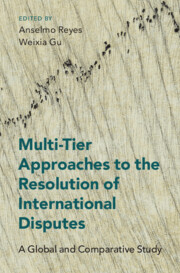Book contents
- Multi-tier Approaches to the Resolution of International Disputes
- Multi-tier Approaches to the Resolution of International Disputes
- Copyright page
- Contents
- Figures
- Tables
- Contributors
- Acknowledgements
- Table of Cases
- Table of STATUTES AND INSTRUMENTS
- Table of Rules, Codes and Guidelines
- Abbreviations
- Part I A Global Overview of Multi-tier Dispute Resolution: Main Themes
- Part II Multi-tier Dispute Resolution in Asia
- Part III Multi-tier Dispute Resolution in the Wider World
- 11 Multi-tier Commercial Dispute Resolution Processes in the United States
- 12 Multi-tiered Dispute Resolution Clauses
- 13 Multi-tier and Mixed-Method Dispute Resolution in Canada
- 14 Multi-tier Dispute Resolution in Australia
- 15 Praised, but Not Practised
- 16 Multi-tier Dispute Resolution in Russia
- 17 Multi-tier Dispute Resolution under OHADA Law
- Part IV Conclusion
- Bibliography
- Index
14 - Multi-tier Dispute Resolution in Australia
A Tale of ‘Escalating’ Acceptance
from Part III - Multi-tier Dispute Resolution in the Wider World
Published online by Cambridge University Press: 09 December 2021
- Multi-tier Approaches to the Resolution of International Disputes
- Multi-tier Approaches to the Resolution of International Disputes
- Copyright page
- Contents
- Figures
- Tables
- Contributors
- Acknowledgements
- Table of Cases
- Table of STATUTES AND INSTRUMENTS
- Table of Rules, Codes and Guidelines
- Abbreviations
- Part I A Global Overview of Multi-tier Dispute Resolution: Main Themes
- Part II Multi-tier Dispute Resolution in Asia
- Part III Multi-tier Dispute Resolution in the Wider World
- 11 Multi-tier Commercial Dispute Resolution Processes in the United States
- 12 Multi-tiered Dispute Resolution Clauses
- 13 Multi-tier and Mixed-Method Dispute Resolution in Canada
- 14 Multi-tier Dispute Resolution in Australia
- 15 Praised, but Not Practised
- 16 Multi-tier Dispute Resolution in Russia
- 17 Multi-tier Dispute Resolution under OHADA Law
- Part IV Conclusion
- Bibliography
- Index
Summary
The Australian approach to multi-tier dispute resolution and arb-med clauses may be described as one of progressive acceptance. Australian courts now generally recognise and give effect to negotiation and mediation clauses, where entered into as a prerequisite to litigation or arbitration. ‘Good faith’ negotiation clauses and ‘agreements to agree’ a future dispute resolution process are also increasingly accepted, although clauses which are futile or unconscionable will not be enforced.
The current regime for arb-med was introduced in Australia in uniform State and Territory domestic arbitration legislation from 2010 and is based on the Singapore and Hong Kong models. While a recent New South Wales decision reveals a willingness to support the process, concern exists about the strict requirement for party consent to a mediator continuing to act as arbitrator. There is currently no scope for parties to choose arb-med in an international arbitration seated in Australia.
- Type
- Chapter
- Information
- Multi-Tier Approaches to the Resolution of International DisputesA Global and Comparative Study, pp. 343 - 362Publisher: Cambridge University PressPrint publication year: 2021

